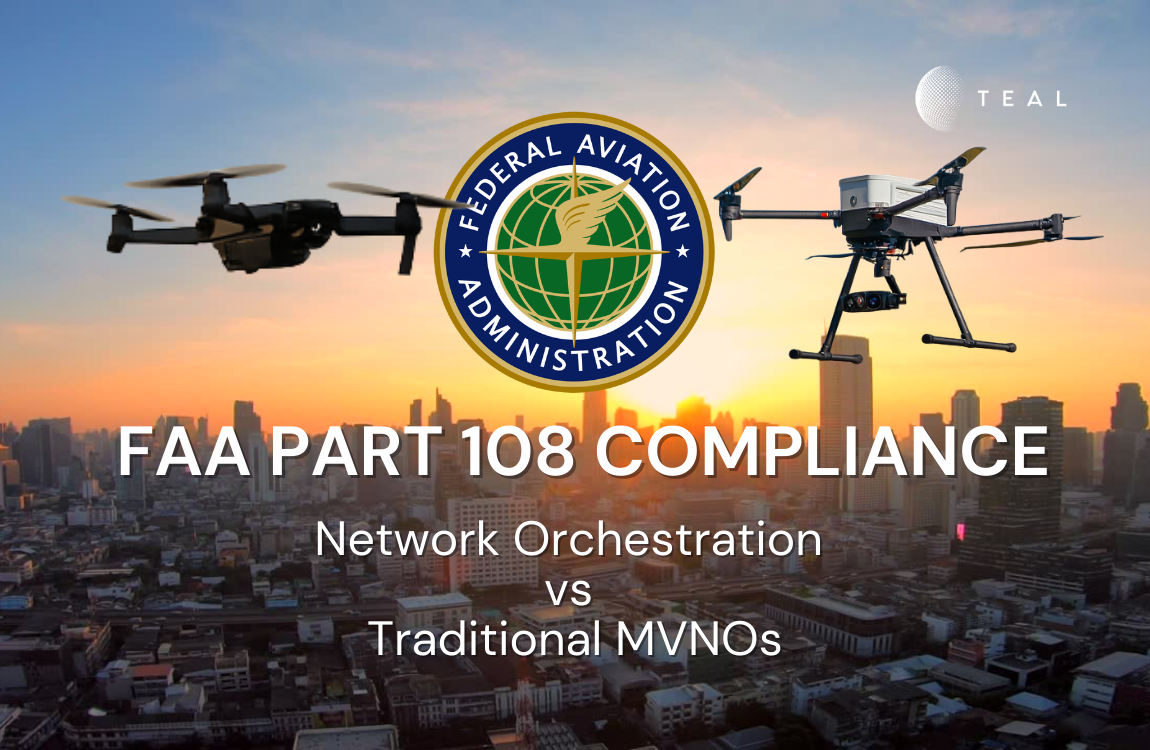Why TEAL’s Network Orchestration Beats Traditional MVNOs for FAA Part 108 Compliance

The Federal Aviation Administration’s (FAA) long-awaited Notice of Proposed Rulemaking (NPRM) for Part 108 has finally arrived, establishing the regulatory framework that will govern Beyond Visual Line of Sight (BVLOS) drone operations. This groundbreaking regulation promises to transform commercial drone operations by eliminating individual waiver requirements and creating standardized safety protocols. However, the 700+ page document contains specific connectivity requirements that will fundamentally reshape how drone operators approach their communications infrastructure.
For organizations planning to operate drones beyond visual line of sight, understanding these connectivity requirements isn’t just important, it’s mission-critical. The FAA’s performance-based approach establishes strict standards for reliability, security, and integration that will separate compliant operators from those left grounded.
This analysis examines what Part 108 really demands from connectivity solutions, why traditional Mobile Virtual Network Operators (MVNOs) fall short of these requirements, and how TEAL’s Network Orchestration Service (NOS) provides the mission-critical connectivity that modern drone operations require.
Understanding Part 108’s Connectivity Foundation
FAA Part 108 represents the most significant advancement in drone regulation since Part 107’s introduction. The proposed rule creates a structured pathway for routine BVLOS operations without individual waivers, fundamentally changing how commercial drone operations scale across industries.
The regulation establishes performance-based safety requirements covering detect-and-avoid systems, communications, and navigation standards. Operations must remain at or below 400 feet above ground level and originate from pre-approved, access-controlled launch sites. Most importantly, Part 108 shifts accountability from individual pilots to operating companies, reflecting the industrial nature of BVLOS operations where systematic safety management becomes more critical than individual pilot judgment.
Early data demonstrates massive industry demand for these standardized operations. BVLOS waiver approvals jumped from approximately 1,200 in 2020 to nearly 27,000 in 2023, highlighting the urgent need for scalable connectivity solutions that can support this explosive growth.
Part 108’s Three Critical Connectivity Pillars
The NPRM establishes three fundamental connectivity requirements that operators must implement for compliant BVLOS operations. These requirements extend far beyond simple radio communication, demanding sophisticated digital infrastructure integration.
Remote ID via UAS Service Suppliers (USS)
All BVLOS flights under Part 108 must maintain continuous connectivity to an FAA-certified UAS Service Supplier. This requirement mandates internet-enabled data transmission throughout the entire mission, continuously broadcasting position, identification, and operational status updates. The Remote ID system includes enhanced operational status messaging that specifically indicates BVLOS operation mode and takeoff location, optimized to enable situational awareness for other aircraft.
Automated Data Service Provider (ADSP) Integration
Operators must connect to FAA-approved Automated Data Service Providers for real-time operational coordination. ADSPs serve as critical middleware between drone operators and the broader airspace management system, handling strategic deconfliction of flight plans, airspace coordination, and communication of operational updates. This requirement becomes mandatory for operations in controlled airspace and flights over areas with population density of Category 3 or higher.
Performance-Based Communications Standards
The NPRM establishes rigorous performance standards for command and control (C2) communications. These standards require secure uplink and downlink telemetry with sufficient data rates to support detect-and-avoid systems effectively. Communication systems must demonstrate reliable coverage throughout the area of operations, with documented monitoring plans and lost-link procedures. Real-time health monitoring and failure alerting becomes mandatory, with systems executing predetermined safe actions when reaching link timeout thresholds.
The MVNO Limitation: Why Traditional Solutions Fall Short
Mobile Virtual Network Operators (MVNOs) have historically attracted businesses with competitive pricing and flexible service offerings. However, MVNOs face fundamental limitations that make them unsuitable for FAA Part 108 compliance, particularly when mission-critical drone operations are at stake.
Lack of Network Control
MVNOs lease network access from major carriers but lack direct control over core network parameters. They cannot access low-level Quality of Service controls or prioritize mission-critical UAV data during network congestion. When BVLOS operations require guaranteed performance characteristics, this limitation becomes critical. Part 108’s performance-based requirements demand carrier-grade commitments that MVNOs simply cannot enforce through their wholesale relationships with network operators.
Security Architecture Gaps
MVNOs don’t control core security infrastructure, making it difficult to implement end-to-end encryption policies or enforce SIM-based authentication aligned with FAA and NIST cybersecurity standards. Part 108’s cybersecurity provisions require operators to develop comprehensive policies protecting networks, devices, and data from unauthorized access—requirements that MVNOs cannot adequately support.
Roaming Limitations Create Operational Risk
Standard roaming solutions introduce several challenges that are particularly problematic for mission-critical drone operations:
- Latency and instability from roaming connections compromise real-time command and control
- Lack of real-time network switching leads to delayed failover and potential connection loss
- Limited redundancy with restricted carrier options in roaming agreements
- Security vulnerabilities from ever-changing, untrusted international networks
International roaming support through MVNOs relies on complex partner arrangements that create unpredictable connectivity across borders. For operations requiring global coverage, these limitations become operational show-stoppers.
Missing Regulatory Integration
Perhaps most critically, MVNOs lack the regulatory traceability and UTM integration capabilities that Part 108 demands. The regulation requires deep integration with airspace management systems and traceable SIM device ownership that MVNOs cannot readily provide.
TEAL’s Network Orchestration Service (NOS): Policy-Aligned for Part 108
TEAL provides a US-built, secure, carrier-agnostic connectivity platform specifically designed for uncrewed aircraft systems operating under FAA Part 108. Unlike traditional MVNOs or single-network providers, TEAL’s Network Orchestration Service (NOS) offers dynamic network orchestration across multiple Tier-1 carriers, ensuring the resilient, redundant, and low-latency links that BVLOS operations require.
Real-Time Network Switching and Redundancy
TEAL’s eSIM technology can dynamically switch between carriers in real time to maintain strong signals across varied geographies—crucial for the redundant, resilient command and control links required under Part 108. This capability provides seamless failover and coverage optimization that traditional roaming solutions cannot match.
The platform enables single SIM, dynamic carrier switching rather than requiring separate SIMs and contracts for different carriers. This approach eliminates downtime for physical reconfiguration when network changes are needed, ensuring continuous connectivity even in marginal coverage areas.
Cybersecurity and Sovereign Control
Built entirely in the United States and GSMA-certified, TEAL’s platform ensures full control over provisioning and data paths, meeting rising FAA and federal expectations around cyber and supply chain security. The platform supports:
- SIM-based identity and secure provisioning aligned with FAA cybersecurity mandates
- End-to-end SIM traceability and identity management
- Geofenced policy enforcement enabling compliant operations across varied airspace and jurisdictions
Performance Standards That Meet Part 108 Requirements
TEAL’s platform delivers the performance characteristics that Part 108 demands:
- Native Tier-1 carrier profiles for low-latency, high-throughput performance not hindered by roaming limitations
- Network-level QoS and SLAs that meet BVLOS latency and reliability needs
- Carrier-agnostic connectivity with intelligent fallback ensuring continuous communication
- Multi-carrier QoS selection plus redundancy for mission-critical operations
Integration with UTM and ADSP Ecosystems
TEAL’s platform provides direct support for UTM ecosystem integration, facilitating safe and coordinated BVLOS flights without requiring operators to manage complex integration projects internally. This capability is essential for Part 108 compliance, which requires seamless integration with FAA-approved Automated Data Service Providers.
The Strategic Advantage: Comparing Connectivity Solutions
The differences between connectivity approaches become clear when examining their capabilities against Part 108 requirements:
Network Control: While MVNOs have no network control and MNOs provide full control over their specific networks, TEAL offers dynamic control via API orchestration across multiple networks.
Quality of Service: MVNOs cannot provide low-level QoS configuration, MNOs offer SLA-backed QoS support for their network, but TEAL delivers multi-carrier QoS selection with built-in redundancy.
Security and Compliance: MVNOs provide weak security with no core access guarantees, MNOs offer controlled environments, while TEAL combines SIM-based identity with secure provisioning across multiple carriers.
Global Scalability: TEAL provides pre-provisioned access to hundreds of networks across 196+ countries, positioning operators for international expansion as BVLOS regulations harmonize globally.
Preparing for Part 108 Success
Organizations planning to operate under Part 108 should begin connectivity preparation immediately. The regulation’s performance-based approach creates opportunities for innovation while maintaining strict safety standards.
Technical Infrastructure Development
Evaluate connectivity solutions that can provide both cellular and satellite communication links for robust command and control capabilities. Design systems with dynamic spectrum capability, allowing fallback between different communication methods based on signal quality and geographic coverage.
Implement detect-and-avoid systems integrated with your connectivity infrastructure for real-time alerting and evasive control. Ensure all devices and networks meet expected cybersecurity baseline protections while maintaining continuous Remote ID broadcast capability.
Operational Framework Establishment
Develop operations manuals reflecting new roles like Flight Operations Supervisor and Flight Coordinator with appropriate training documentation. Create chain of control procedures facilitating quick transfer of control during communication degradation, including automated return-to-home or safe-land triggers on link failure.
Document communication coverage throughout planned operational areas with detailed lost-link procedures for each location. Establish real-time health monitoring systems with immediate failure notification to operations centers.
Why TEAL Represents the Future of BVLOS Connectivity
The future of Part 108 compliance lies in flexible, carrier-agnostic connectivity platforms that can adapt to changing operational requirements and regulatory demands. Traditional single-carrier approaches and MVNO solutions lack the resilience and flexibility that BVLOS operations demand.
TEAL’s dynamic eSIM network orchestration represents the most promising approach to Part 108 connectivity compliance. The platform provides real-time network switching for seamless failover and coverage optimization while maintaining end-to-end SIM traceability and identity management aligned with FAA requirements.
In the context of Part 108’s performance-based standards for safety, connectivity assurance, and regulatory traceability, TEAL represents not just a connectivity provider, but a mission-critical compliance enabler. Organizations that invest in TEAL’s flexible, resilient connectivity solution will be better positioned to adapt to evolving regulations and operational demands.
Taking the Next Step Toward Compliance
FAA Part 108 represents more than regulatory compliance—it establishes the foundation for routine commercial drone operations at unprecedented scale. The connectivity requirements embedded within this regulation will determine which organizations successfully transition from experimental operations to industrial-scale deployment.
Don’t let inadequate connectivity solutions ground your BVLOS operations. TEAL’s Network Orchestration Service provides the mission-critical connectivity infrastructure that Part 108 demands, with the flexibility and security that modern drone operations require.
Find out how you can ensure policy-aligned connectivity for your BVLOS drone operations. Schedule a free consultation with a TEAL expert today and discover why leading drone operators are choosing TEAL’s carrier-agnostic platform over traditional connectivity solutions.
Recent Posts
Introducing TEAL Chameleon eSIM: The Most Adaptive eSIM Ever Built
Teal Communications Staff2025-12-03T23:14:56+00:00
TEAL Ranked as the Fastest-Growing Company in the Pacific Northwest on the 2025 Deloitte Technology Fast 500™
Teal Communications Staff2025-11-19T04:37:11+00:00
SenseNet Partners With TEAL to Expand AI-Powered Wildfire and Gas Leak Detection Globally
Teal Communications Staff2025-11-12T17:24:11+00:00




